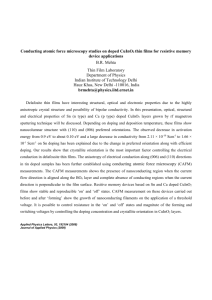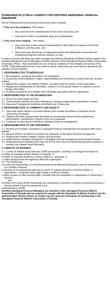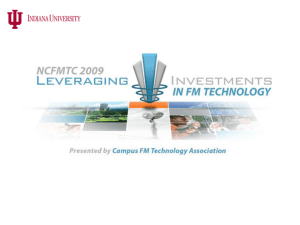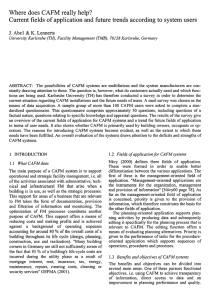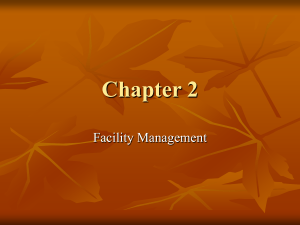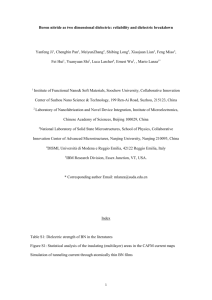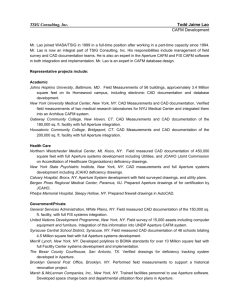Document 13134229
advertisement
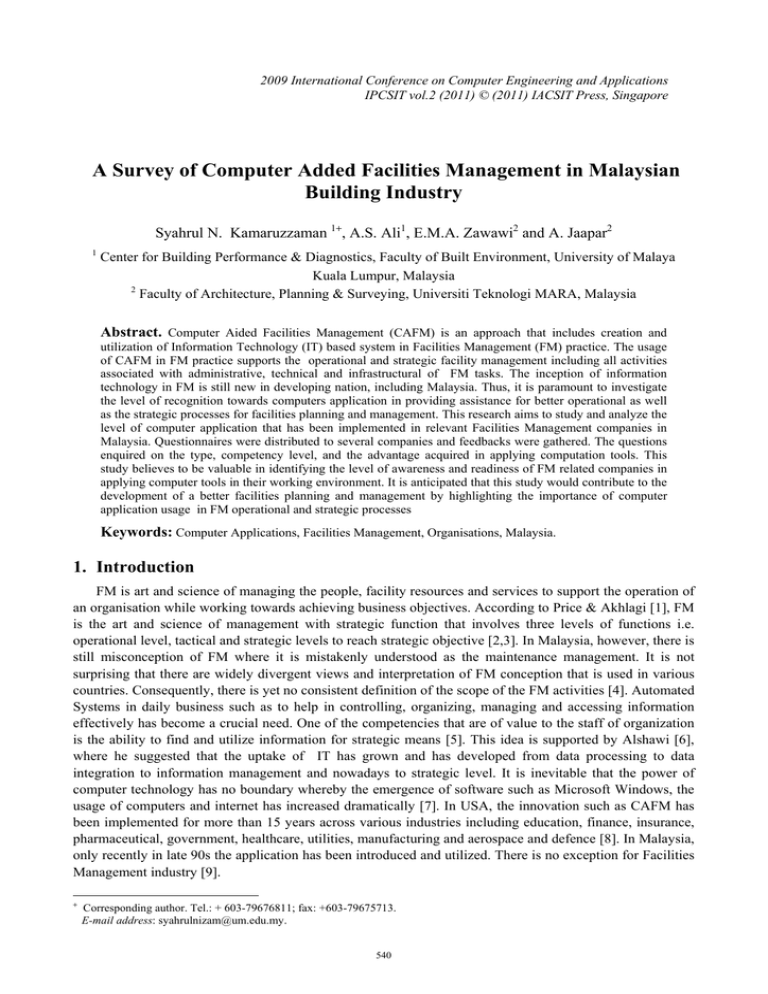
2009 International Conference on Computer Engineering and Applications IPCSIT vol.2 (2011) © (2011) IACSIT Press, Singapore A Survey of Computer Added Facilities Management in Malaysian Building Industry Syahrul N. Kamaruzzaman 1+, A.S. Ali1, E.M.A. Zawawi2 and A. Jaapar2 1 Center for Building Performance & Diagnostics, Faculty of Built Environment, University of Malaya Kuala Lumpur, Malaysia 2 Faculty of Architecture, Planning & Surveying, Universiti Teknologi MARA, Malaysia Abstract. Computer Aided Facilities Management (CAFM) is an approach that includes creation and utilization of Information Technology (IT) based system in Facilities Management (FM) practice. The usage of CAFM in FM practice supports the operational and strategic facility management including all activities associated with administrative, technical and infrastructural of FM tasks. The inception of information technology in FM is still new in developing nation, including Malaysia. Thus, it is paramount to investigate the level of recognition towards computers application in providing assistance for better operational as well as the strategic processes for facilities planning and management. This research aims to study and analyze the level of computer application that has been implemented in relevant Facilities Management companies in Malaysia. Questionnaires were distributed to several companies and feedbacks were gathered. The questions enquired on the type, competency level, and the advantage acquired in applying computation tools. This study believes to be valuable in identifying the level of awareness and readiness of FM related companies in applying computer tools in their working environment. It is anticipated that this study would contribute to the development of a better facilities planning and management by highlighting the importance of computer application usage in FM operational and strategic processes Keywords: Computer Applications, Facilities Management, Organisations, Malaysia. 1. Introduction FM is art and science of managing the people, facility resources and services to support the operation of an organisation while working towards achieving business objectives. According to Price & Akhlagi [1], FM is the art and science of management with strategic function that involves three levels of functions i.e. operational level, tactical and strategic levels to reach strategic objective [2,3]. In Malaysia, however, there is still misconception of FM where it is mistakenly understood as the maintenance management. It is not surprising that there are widely divergent views and interpretation of FM conception that is used in various countries. Consequently, there is yet no consistent definition of the scope of the FM activities [4]. Automated Systems in daily business such as to help in controlling, organizing, managing and accessing information effectively has become a crucial need. One of the competencies that are of value to the staff of organization is the ability to find and utilize information for strategic means [5]. This idea is supported by Alshawi [6], where he suggested that the uptake of IT has grown and has developed from data processing to data integration to information management and nowadays to strategic level. It is inevitable that the power of computer technology has no boundary whereby the emergence of software such as Microsoft Windows, the usage of computers and internet has increased dramatically [7]. In USA, the innovation such as CAFM has been implemented for more than 15 years across various industries including education, finance, insurance, pharmaceutical, government, healthcare, utilities, manufacturing and aerospace and defence [8]. In Malaysia, only recently in late 90s the application has been introduced and utilized. There is no exception for Facilities Management industry [9]. + Corresponding author. Tel.: + 603-79676811; fax: +603-79675713. E-mail address: syahrulnizam@um.edu.my. 540 2. Computer Aided Facilities Management (CAFM) Computer Aided Facilities Management (CAFM), is a high tech tool which is a combination of computerized network system that connects graphic and non graphic information in a centralized manner using widespread data collection. These are used by facilities professionals to track and manage virtually any facilities related asset, provides managers and decision maker with the ability to analyze the effective use of space readily than ever [10]. Based on the study made by Keller & Keller [8], CAFM must be improved from time to time to bring the strategic efficacy to the facility management. Even though during the initial stage, the implementation of CAFM was not favourable to most of the staff, the disastrous catastrophe of World Trade Centre on September 11, 2001 had led to a fresh impetus to innovation and adaptability in CAFM. In general, when FM is part of business organization, it has to go by the flow with the world of constant change. In order to survive, the management of organization’s facilities who has the largest asset on the balance-sheet has to manage its asset efficiently [11]. "For most organizations, rental occupancy costs represent the second largest cost category, after payroll expenses" [12]. Thus, CAFM must not only address solutions to facility management problems, but shall be part of a complete business strategy to control occupancy expenses and maximize occupancy efficiency. 3. Data Gathering/Methodology A set of questionnaires were sent to a total of 24 organizations consisting of facilities management FM companies and various organizations’ that has FM department. The questionnaires consisted of eight (8) questions inquiring on the type, competency level, and the advantage acquired in applying computation tools. In addition, the cost implication on investing in computer application is also enquired. The questionnaires were sent out via e-mail, fax and verbal interviews were also conducted through telephone. 4. Analysis of results Analysis was conducted to understand the overall application of computer in the FM organization. In Figure 1 below, it is found that most organisations i.e. 71% have used work program for scheduling and CAD for architectural drawing. 18 respondents depended on Central Monitoring Systems (CMS) and Building Automated System (B.A.S) to assist in daily facilities management whereas 6% uses C WORKS, while the rest used their own custom made software that suits their organization needs and strategic goal. IT SOFTWARE APPLICATION IN ORGANIZATION Percentage Of Usage 120% 100% 80% 60% Percentage 40% 20% .S .A O th er s B M Y O B rc hi bu s A M S C w or ks C E XE L Pr og ra m e In te rn et A ut oC A D W or k M ic ro so ft W or ds 0% Type of Software Figure 1. IT software application in Organization 80% 70% 60% 50% 40% 30% 20% 10% 0% Daily Usage Others Efficient No Save cost & overhead May be Yes 5 4 3 2 Series1 1 Percentage RESPONSE TO QUESTION NO 4 - 6 Company will be at Yes and Maybe, the competitive Potential Factor Answer Figure 2. The impact of computer tools 541 In response to question regarding their daily usage of IT (Figure 2), 41% of the respondents stated that they used computer tools averagely while, 29% used computer tools heavily as they totally depended on the computer in daily business operation. When asked whether a company will be at competitive advantage, 38% answered yes, 54% answered may be while 8% said no. When countered with the question of why they said “may be and no”, the 62% of the respondents said it depends on the client’s requirement and they have their own strength and need not have CAFM to be at competitive advantage. As for cost saving and efficiency, 41% agreed that it will save overhead cost and 71% agreed that the use of CAFM will help in efficiency, while 12% said other i.e. it helps in job tracking and accurate reporting. REASONABLE COST FOR CAFM SOFTWARE PERCENTAGE 60% 50% 40% 30% Series1 20% 10% 0% Yes May be No Cost within RM30K -RM50K reasonable ANSWER Figure 3. Feedback of reasonable cost for CAFM software The question whether the CAFM software at RM30,000 – RM50,000 (USD 8199 – 13665.00) is reasonable or not, has received variance of answers whereby 24% said yes and no, while the rest of 52% said may be (Figure 3). This is further confirmed by the conducted semi-structured interviews to the respondents of the questionnaires. During the interview, they were asked similar question on why they said no. Some said the cost in reality is far too high than suggested while others said the cost should be less than RM30,000 (USD 8199.00). It is believed that since there are a lot of similar pirated software available in the market and the cost should be reciprocal of time i.e. in later stage the cost will get cheaper and cheaper. 5. Discussion of findings Comparison of company’s year of establishment was done to determine whether the new company willing to invest to compete in the market or the long established company willing to invest to keep the long standing data organized and so forth. However the most interesting fact achieved was, the use of IT especially the internet is a must in present business operation. IT USAGE BASED ON NUMBER OF YEARS OF COMPANY'S ESTABLISHMENT PERCENTAGE USE 120% 100% 80% 60% <10 years 10-20 years 40% >20 years 20% C M S C wo rk s M YO B Ar ch ib us B .A .S O th er s EX EL Pr og ra m e In te rn e Au t to CA D W or k M ic ro -s of t W or ds 0% TYPE OF SOFTWARE Figure 4. IT Usage based on number of years establishment When compared between years of establishment, every organization regardless of its age have subscribed to basic computer needs such as Microsoft Words, Excel and Internet. Regarding work program software, in this finding as shown in figure 4, the companies that are <10 years uses the work program extensively i.e. 83%, whereas for CAD(Computer Aided Design), the companies that are 10 – 20 years of establishment and company < 10 years of establishment are 100% and 83% using computer tools respectively. When asked the 542 long established company, they normally outsource to the consultant for the architectural drawings. As for other software such as CMS, C WORKS, MYOB, B.A.S and others showed a different pattern of graph. Organizations that aged between 10 – 20 years utilize the CMS(25%) and C WORKS (25%) and others (50%) program. The companies that are more than 20 years of establishment use CMS (29%), MYOB (14%), B.A.S (43%) and others (29%). The reason why the long established companies used CMS and B.A.S because mostly have their own building to manage and the CMS and B.A.S have been used to help in daily building services maintenance work. COMPARISON OF QUESTION 4- 6 120% Percentage 100% 80% <10 years 10-20 years >20 years 60% 40% Daily Usage Others Efficient & overhead No Save cost Yes 5 4 3 2 1 0% May be 20% Company will be at Yes and Maybe, the Potential Factor competitive would be advantage if applies CAFM Answer Figure 5. Comparison of IT usage In term of daily usage rate as per figure 5, the distribution is quite contradicting to earlier question as 71% stated that they are heavily using computers in daily business. Nevertheless, 75% of the medium age company states that their usage is very much average. When asked if the company will be at competitive advantage if they have CAFM, the less established company mostly states “may be” (67%) and 33% states “yes”. As for the medium established company “may be” (50%) answer overtook “yes” (25%) and “no” (25%) answer. The long established company however has a fickle answer where 43% answered “yes” and “maybe” and the rest did not answer. Above all, 100% of young breed companies agreed that CAFM is a potential factors in helping business efficiency with 17% also agreed that it will save cost. For the medium age company and long established company, 75%and 43% agreed that it also will save cost and enhance business efficiency, respectively. Furthermore, 29% of the long established company stated other potential factors such as for easy job tracking and reporting. COMPARISON OF ACCEPTED COST BASED ON COMPANY'S YEAR OF ESTABLISHMENT 90% 80% 70% Percentage 60% <10 years 50% 10-20 years 40% >20 years 30% 20% 10% 0% Yes May be No Cost within RM30K -RM50K reasonable Answer Figure 6. Comparison of accepted cost for different companies Finally, figure 6 shows that the newly established company seems undecided on what is the reasonable cost as 93% of them answered “may be” as to whether RM30,000 – RM50,00 (USD 8199 – 13665) is the reasonable cost for the CAFM software. This “may be” answer is because they depend on the project awarded to them, unless if the project worth certain target then only they will decide on implementing the CAFM software application in their daily business operation. 50% of medium age companies agree that the cost is reasonable, whereas the rest of them voted for “may be” (25%) and “no” (25%). 29% of long established companies answered “yes” and “no” with 43% answered “may be”. It is believed that the 543 companies may have become complacent with their systems and work process that they thought the current work process is efficient enough and does not require any CAFM software. 6. Conclusion Movement to technical management has been rapid in the FM industries while other industries still rely in the antiquated administrative approach. Industries with more linear structures and processes typically are more inclined to implement technical systems because ongoing management of these systems can be maintained by a top down organizational structure. Based on this study, it was discovered that almost 100% of the FM companies surveyed are applying IT specifically on computer applications tools in their daily business depending on the organization needs and strategic goal. It also agreed that computer application provide organization with competitiveness advantages as well as enhancing efficiencies. On one hand, not many companies are willing to invest as they believed that the initial cost for computer tools are highly expensive. Comparatively, medium age companies believed that RM30,000-RM50,000 (USD 8199 – 13665.00) are a reasonable investment whereas the long and newly establishes companies are still unsure and sceptical in the amount of money to invest. It is believed that the challenge for facility managers is to utilize the resources available and convincing leadership that efficiencies and cost savings can be achieved with investment in technology, such as a well planned CAFM system. Malaysia is still at their infancy level especially in applying computer tools within the FM industry. Catching up with the system are important to enable the facility managers to become effective decision makers and provide effective management of facility information. It is anticipated mature level will help the facility’s manager to ensure the organizations assets are fully utilized at the lowest possible cost, while providing benefit to every phase of a building’s lifecycle 7. References [1] Price, I. and Akhlaghi, F. "New patterns in facilities management: industry best practice and new organisational theory", Facilities, Vol. 17 1999, No. 5/6. [2] Bon, R., McMahan, J.F. and Carder, P.,”Property performance measurement: from theory to practice”, Facilities, Vol. 16 Nos 7/8, 1998, pp. 208-14. [3] Barrett P, “Achieving strategic facilities management through strong relationships”, Facilities (UK), Vol 18 No 10/11/12, 2000. [4] Zuhairi A. Hamid, “Construction Research Institute of Malaysia”, unpublished. [5] M. Jalil, A. N., “Introduction to Information”, unpublished. [6] M. Alshawi and I. Faraj, “Integrated Construction environments: technology and implementation’ Construction Innovation:Information, Process, Management, Vol 2, issue 1, 2002, pp 33-51 [7] Y. M. Lim, and C. T. Ong, “A Quick Survey on the use of CBSM” Journal of Surveyor, , Vol 43, No 1, 2008. [8] Jenifer W. Keller, and C. Keller, “Bringing Strategic Efficacy to Facility Management Trough CAFM tools’” Facilities Journal, 2,3 Sept 2004, , ABI/INFORM Global Page 125 [9] Jamilus, “National Asset and Facilities Management Malaysia”, unpublished. [10] Supornchai Saengratwatchara, Jeffery D. Elsworth., “Antecedents of Intention to Adopt the Web Based CAFM Systems” Family and Consumer Science Research Journal. Thousand Oaks, Vol 36, Iss 4 ,June 2008, pg 350 – [11] Lunn, S.D., and Stephenson, P. "The Impact of Tactical and Strategic FM Automation" Facilities, Vol. 18, (2000), pg. 312. [12] Mokrauer, Aronow, Mokrauer, New York State Society of CPAs, "Lease Compliance Review: An Emerging Trend in Client Services," CPA Journal (http://www.nysscpa.org/cpajournal/2000/0100/f3100a.html). 544
